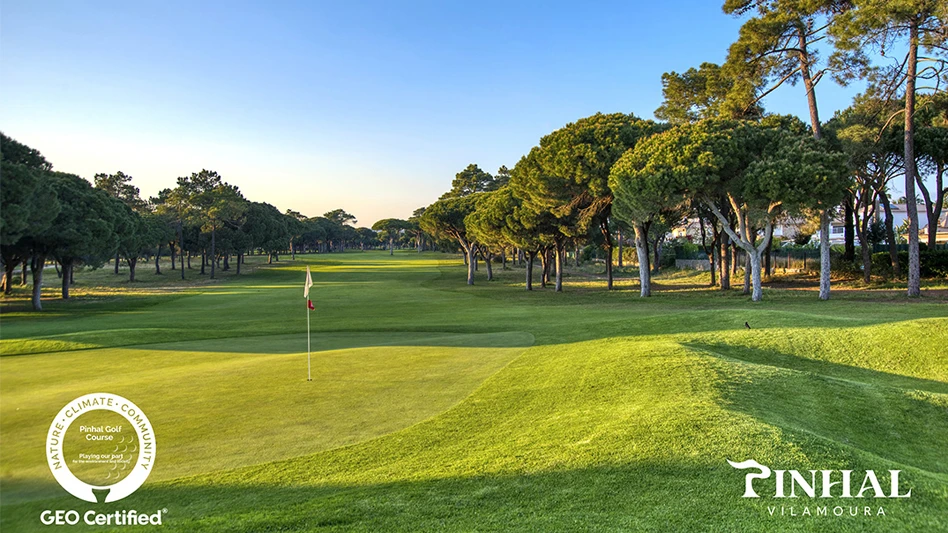 “If I could only make one fertilizer application a year, fall would definitely be the one I would make,” says Dr. Jeff Higgins, business development and strategic accounts vice president with Harrell’s and the former director of agronomy for ValleyCrest Golf Course Maintenance. That critical fall fertilizer treatment becomes even more important when it’s followed by harsh winter conditions such as those experienced in many parts of the country in the past two years, if courses are to emerge from the cold with healthy, playable turf.
“If I could only make one fertilizer application a year, fall would definitely be the one I would make,” says Dr. Jeff Higgins, business development and strategic accounts vice president with Harrell’s and the former director of agronomy for ValleyCrest Golf Course Maintenance. That critical fall fertilizer treatment becomes even more important when it’s followed by harsh winter conditions such as those experienced in many parts of the country in the past two years, if courses are to emerge from the cold with healthy, playable turf.
As superintendents in most parts of the U.S. are well aware, fall is the time when turfgrasses hopefully build up the carbohydrate food reserves to keep them healthy and help fight off cold-weather diseases such as snow mold throughout the winter months. The trick is to provide them with the right diet and dosages of fertilizer at the optimum time to maintain a strong base of downward root growth and carbohydrate supply during the winter to ensure that spring turf “pops” when spring brings warmer temperatures, sunshine and, hopefully, a fresh crop of eager golfers.
Timing for fall fertilizer applications obviously varies throughout the U.S. depending upon local climates, or even micro-climates within a region. One tipoff as to the best time for the final fall fertilization, according to agronomists like Higgins, is when the turf is no longer producing clippings.
“There’s a big misconception about fall fertilization,” Higgins says. “Some people think that it takes place in late summer or early fall, but that’s usually too early. The best time for carbohydrate storage is late fall, but some people miss the timing. Turf management all goes back to carbohydrate management. When the (carbohydrate) food bank is gone, the plant dies.”
While both the timing and the types of fall fertilization are critical in terms of overall turf health through the winter, those decisions can also be affected by the need to maximize golf revenues for as long as the weather permits. Mild fall weather means more golfers, and they expect robust turf until winter consigns their golf clubs to the garage until spring. In cases like that, if the budget permits, superintendents may opt for a late application of quick release fertilizer applications to keep the turf green for as long as possible.
Doug Melchior, superintendent at Sykes/Lady Overland Park Golf Course in Kansas, says that by mid-August, he is typically through the major fertilizing of his zoysia fairways for the rest of the year, but will do some applications on the bluegrass fescue roughs and bentgrass tees and greens in the next couple of months, using quick release products if the weather is favorable and slow release if it is colder. Melchior says his last fertilizer applications for the fall are typically around the first of November. But, he adds, voicing a frequent concern of golf course superintendents almost everywhere, the number and types of applications are also dependent on the state of that year’s maintenance budget. “Some years, we’ve had no fertilizer in the roughs,” he says, a concern that may or not have been shared by the course’s more erratic golfers.
Chris Gray, marketing manager for professional fertilizers at Pennsylvania-based Lebanon Turf, is in full agreement on the importance of a good fall fertilizer program. “Late fall nitrogen fertilization is definitely the best of the year,” he says. “It’s critical in how it relates to your full-year program, getting ready for spring. By promoting strong root growth during the winter, you’re trying to avoid really aggressive spring nitrogen applications which promote shoot growth rather than root growth.”
For fall fertilization, Gray recommends against using nitrogen applications that require a lot of microbial activity for maximum efficiency. He is in favor of using ammonium sulfate-based products or high activity methylene urea products. The critical consideration, he says, particularly in cold winter climates, is promotion of the deepest root growth possible. Additionally, he says, slow release products are more effective in fighting diseases like snow mold throughout the winter, creating a harder cuticle on the turf which helps to protect against winter damage to the plant.
Finding a financial fit
There is some difference of opinion regarding the efficacy of a strong dose of potassium in the fall fertilization recipe book, but both Higgins and his successor as ValleyCrest Director of Agronomy, Dr. Todd Bunnell, are strong supporters. “Potassium plays a key role in fall fertilization,” Higgins says. “It regulates water in plants, and creates more stress tolerance.”
One product that has declined in usage by golf course superintendents over the years, primarily due to its increased cost, is IBDU, a slow release, low water soluble fertilizer application. If the budget can afford it, there is little doubt that it produces greener, healthier looking turf in many cases, but today’s budgets being what they are, its use on golf courses has declined
One superintendent whose budget can afford it is Jeff Corcoran, manager of golf course and grounds at famed Oak Hill Country Club in Rochester, N.Y. Corcoran uses a variety of products to protect the Oak Hill turf, including slower release products like UMAX stabilized urea in the course’s roughs and fairways, a dormant fertilizer with IBDU and snow mold protection consisting of PCNB in combination with a systemic fungicide, typically administered in November.
“As far as IBDU, I like the way it looks in spring when we open for play again,” Corcoran says. “We use it as we go into winter, but it’s just one part of the overall maintenance plan. A cultural program is paramount, and that includes aerification, tree removal and other environmental applications to make sure the turf gets enough air and sunshine. We prepare for the worst every winter, and hope for the best. The key is to take the plant into winter as healthy as possible, and it involves a comprehensive wholesale assessment.”
When it comes to price, Higgins says superintendents would be well advised to read the labels closely when making price-based fertilizer product choices. “A lot of superintendents make decisions based on cost per bag,” Higgins says. “Ammonium sulfate is cheap, but it doesn’t last very long. They should probably price according to the price per week for greening of turf, rather than just the cost per bag. Another thing they should consider is how much fertilizer is in a bag versus how much filler. For maximum results, if you’re using a slow release product, you need 70 to 75 percent slow release fertilizer in the blend, because the rest is likely to be filler.”
“A lot of people are moving toward liquids, but those don’t transport down into the root base, so eventually if that’s all you’re using, it could hurt the turf product,” Higgins adds. “A lot of studies have indicated that a combination of granular and liquid is best. There’s not enough carbohydrate production in the fall with just liquids to last through the winter. Of my 27 years in the golf course industry, I’d have to say that fertilizer is the least understood aspect of turf management.”
The wacky West
The prime motivation for late fall fertilization is preparation of turf to survive and thrive through cold winter seasons, but for those parts of the country where “snow” only occurs where there’s poor TV reception or a shortage of Head & Shoulders, such as the golfing meccas of Palm Springs, Phoenix and (usually) Las Vegas, the process is a bit different. In those areas, many superintendents prepare for winter, their busy season, by overseeding the typical Bermudagrass with rye or other winter varieties, and fertilize for instant growth, not merely winter survival. Pat Gross of the USGA Green Section, Southwest Section, deals with the full spectrum of turf conditions and treatment practices in his widespread domain.
“I’ve always said that the Southwest Section has the most diverse set of turf conditions in the country, with every kind of turf known to man,” Gross says. In addition to the widespread Bermudagrass strains in the desert areas, the section extends to the northern border of California and incorporates the mountainous areas of the Sierra Nevada and Arizona ranges where snow melt and runoff can wreak havoc on granular fertilizer applications.
In the warmer areas that overseed with ryegrass, superintendents push growth with heavy fertilizer applications in October and November, using as much as a half-pound of nitrogen per 1,000 square feet of turf per week. The result is the verdant green we see on television from the West Coast swing of the PGA Tour through Palm Springs and Scottsdale.
Some desert courses further hedge their bets by “scalping” the Bermudagrass turf in preparation for the ryegrass overseed, but Higgins and others feel that is counterproductive because the Bermudagrass has to fight that much harder to reestablish in the spring. On the other hand, Gross notes, there are chemical products on the market which can be sprayed in the spring to eliminate the ryegrass immediately, followed by blasts of ammonium sulfate products to get an almost instant transition back to Bermudagrass.
Jim Dunlap is an Encinitas, Calif.-based freelance writer and frequent GCI contributor.

Explore the October 2014 Issue
Check out more from this issue and find your next story to read.
Latest from Golf Course Industry
- Indiana course upgrades range with synthetic ‘bunkers’
- Monterey Peninsula CC Shore Course renovation almost finished
- KemperSports and Touchstone Golf announce partnership
- PBI-Gordon Company hires marketing manager Jared Hoyle
- Mountain Sky Guest Ranch announces bunker enhancement project
- GCSAA names Joshua Tapp director of environmental programs
- AQUA-AID Solutions bolsters Sunshine State presence
- Escalante Golf acquires secluded Illinois course





